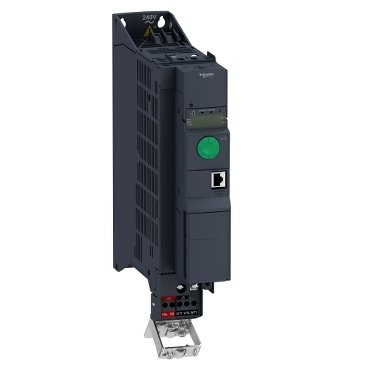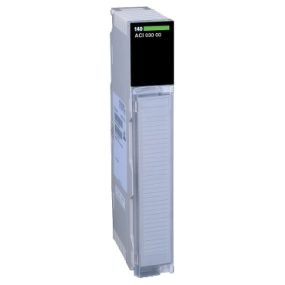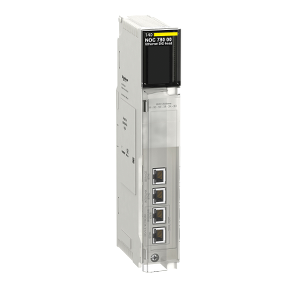Description
| Range of Product | Altivar Machine ATV320. |
|---|---|
| Product or Component Type | Variable speed drive. |
| Product Specific Application | Complex machines. |
| Variant | Standard version. |
| Format of the drive | Book |
| Mounting Mode | Cabinet mount. |
| communication port protocol | Modbus serial. CANopen. |
| Option card | Communication module, CANopen. communication module, EtherCAT. communication module, Profibus DP V1. communication module, PROFINET. communication module, Ethernet Powerlink. communication module, EtherNet/IP. communication module, DeviceNet. |
| [Us] rated supply voltage | 380…500 V = 15…10%. |
| Nominal output current | 5.5 A. |
| Motor power (kW) | 2.2 kW heavy duty. |
| EMC filter | Class C2 EMC filter integrated. |
| IP degree of protection | IP20 |
| Discrete input number | 7 |
|---|---|
| Discrete input type | STO-safe torque off, 24 V DC, 1.5 kOhm. DI1…DI6 logic inputs, 24 V DC 30 V). DI5 is programmable as pulse input (0.30 kHz, 24 V DC, 30 V). |
| discrete input logic | Positive logic (source). Negative logic (sink). |
| Discrete output number | 3 |
| Discrete output type | Open collector DQ+ 0…1 kHz 30 V DC 100 mA. Open collector DQ: 0…1 kHz, 30 V, DC, 100 mA. |
| Analogue input number | 3 |
| Analogue input type | AI1 voltage 0…10 V DC 30 kOhm 10 bits. AI2 bipolar differential voltage +/- 10 V DC 30 kOhm 10 bits. AI3 current: 0…20 mA (or 4-20 mA, x-20 mA, 20-x mA, or other patterns by configuration): 250 Ohm, 10 bits. |
| Analogue output number | 1 |
| Analogue output type | Software-configurable current AQ1: 0…20 mA, 800 Ohm, 10 bits. Software-configurable voltage: AQ1 0…10 V DC 470 Ohm, 10 bits. |
| Relay output type | Configurable relay logic: R1A 1 NO 100000 cycles. Configurable relay logic: R1B 1 NC 100000 cycles. Configurable relay logic: R1C. Configurable relay logic: R2A 1 NO 100000 cycles. Configurable relay logic: R2C. |
| Maximum switching current | Relay outputs R1A, R1B, and R1C are resistive; cos phi = 1 3 A 250 V AC. Relay outputs R1A, R1B, and R1C are resistive; cos phi = 1 3 A 30 V DC. Relay output R1A, R1B, R1C, R2A, R2C inductive, cos phi = 0.4 7 ms 2 A 250 V AC. Relay output R1A, R1B, R1C, R2A, R2C inductive, cos phi = 0.4 7 ms 2 A 30 V DC. Relay output R2A, R2C resistive, cos phi = 1 5 A 250 V AC. Relay output R2A, R2C resistive, cos phi = 1 5 A 30 V DC. |
| Minimum switching current | Relay output R1A, R1B, R1C, R2A, R2C: 5 mA, 24 V DC. |
| Method of access | Slave CANopen. |
| 4 quadrant operation possible | True. |
| Asynchronous motor control profile | Voltage/frequency ratio, 5 points. Flux vector control without sensor, standard. Voltage/frequency ratio: energy Energy Saving, quadratic U/f. Flux vector control without sensor: energy Energy Saving Voltage/frequency ratio, 2 points. |
| Synchronous motor control profile | Vector control without sensor. |
| Transient overtorque | 170…200% of nominal motor torque. |
| Maximum output frequency | 0.599 kHz. |
| Acceleration and deceleration ramps | Linear. U. S CUS.. Ramp switching. Acceleration/deceleration ramp adaptation. Acceleration and deceleration automatically stop with DC injection. |
| Motor slip compensation | Automatic, whatever the load. Adjustable 0…300%. Not available in voltage/frequency ratio (2 or 5 points). |
| Switching frequency | 2…16 kHz adjustable. 4…16 kHz with derating factor. |
| Nominal switching frequency | 4 kHz. |
| Braking to standstill | By DC injection. |
| Brake chopper integrated | True |
| Line current | 8.7 A 380 V heavy duty). 6.6 A, 500 V (heavy duty). |
| Maximum Input Current per Phase | 8.7 A. |
| Maximum output voltage | 500 V. |
| Apparent power | 5.7 kVA (500 V heavy duty). |
| Network Frequency | 50-60 Hz. |
| Relative symmetric network frequency tolerance | 5 % |
| Prospective line Isc | 5 kA |
| Base load current at high overload | 4.8 A |
| Power dissipation in W | Fan 74.0 W 380 V 4 kHz. |
| With safety function Safely Limited Speed (SLS) | True |
| With safety function Safe brake management (SBC/SBT) | False |
| With safety function Safe Operating Stop (SOS) | False |
| With safety function Safe Position (SP) | False |
| With safety function Safe programmable logic | False |
| With safety function Safe Speed Monitor (SSM) | False |
| With safety function Safe Stop 1 (SS1) | True |
| With SFT-FCT Safe Stop 2 (SS2) | False |
| With safety function Safe torque off (STO) | True |
| With safety function Safely Limited Position (SLP) | False |
| With safety function Safe Direction (SDI) | False |
| Protection type | Input phase breaks drive. Overcurrent between output phases and earth drive. Overheating protection drive. Short-circuit between motor phases drive. Thermal protection drive. |
| Width | 2.36 in. (60 mm). |
| Height | 12.80 in (325.0 mm). |
| Depth | 9.65 in. (245.0 mm). |
| Net Weight | 6.61 lb (US) (3.0 kg). |
| Operating position | Vertical +/- 10 degrees. |
|---|---|
| Product Certifications | CE. ATEX NOM GOST EAC RCM KC |
| Marking | CE ATEX UL CSA EAC RCM |
| Standards | EN/IEC 61800-5-1. |
| Electromagnetic compatibility | Electrostatic discharge immunity test level 3: IEC 61000-4-2. Radiated radio-frequency electromagnetic. field immunity test level 3 (IEC 61000-4-3. Electrical fast transient/burst immunity test level 4 (IEC 61000-4-4. 1.2/50 µs–8/20 µs surge immunity test level 3 IEC 61000-4-5. Conducted radio-frequency immunity test level 3 (IEC 61000-4-6. Voltage dips and interruptions immunity test (IEC 61000-4-11. |
| Environmental class (during operation) | Class 3C3, according to IEC 60721-3-3. Class 3S2 according to IEC 60721-3-3. |
| Maximum acceleration under shock impact (during operation) | 150 m/s2 at 11 ms. |
| Maximum acceleration under vibrational stress (during operation) | 10 m/s2 at 13…200 Hz. |
| Maximum deflection under vibratory load (during operation) | 1.5 mm at 2…13 Hz. |
| Permitted relative humidity (during operation) | Class 3K5 according to EN 60721-3. |
| Volume of cooling air | 2985.20 Gal/hr (US) (11.3 m3/h). |
| Overvoltage category | III |
| Regulation loop | Adjustable PID regulator. |
| Speed accuracy | +/- 10 % of nominal slip 0.2 Tn to Tn. |
| Pollution degree | 2. |
| Ambient air transport temperature | -13…158 °F (-25…70 °C). |
| Ambient air temperature for operation | 14…122 °F (-10…50 °C) without derating. 122…140 °F (50…60 °C) with derating. factor. |
| Ambient Air Temperature for Storage | -13…158 °F (-25…70 °C). |
| Category | 22152-ATV320/ATV312/ATV32 (.25 THRU 7.5HP). |
|---|---|
| Discount Schedule | CP4B. |
| GTIN | 3606480931260. |
| Returnability | Yes |
| Country of origin | ID |
| Unit Type of Package 1 | PCE |
|---|---|
| Number of Units in Package 1 | 1 |
| Package 1: Height | 3.78 in (9.600 cm). |
| Package 1: Width | 10.83 in (27.500 cm). |
| Package 1 Length | 12.80 in (32.500 cm). |
| Package 1: Weight | 6.00 lb (US) (2.722 kg). |
| Unit Type of Package 2 | P06 |
| Number of Units in Package 2 | 20 |
| Package 2: Height | 29.53 in (75.000 cm). |
| Package 2 Width | 23.62 in (60.000 cm). |
| Package 2 Length | 31.50 in (80.000 cm). |
| Package 2: Weight | 151.59 lb (US) (68.760 kg). |
Overview of the ATV320U22N4B Schneider Electric Variable Frequency Drive
The ATV320U22N4B is a compact and versatile variable frequency drive (VFD) manufactured by Schneider Electric, designed to control the speed and torque of three-phase asynchronous motors in industrial and commercial applications. This drive belongs to the Altivar Machine range, offering advanced features for improved energy efficiency, motor control, and system integration.
Key Features and Specifications
- Power and Performance:
- The ATV320U22N4B is rated for a power output of 22 kW (30 HP), making it suitable for a wide range of motor control applications in various industries.
- It supports a three-phase input voltage ranging from 380V to 480V, ensuring compatibility with standard industrial power systems.
- Motor Control Capabilities:
- This VFD provides precise control over motor speed and torque, optimizing energy consumption and enhancing process efficiency.
- It supports sensorless flux vector control (SFVC) and scalar control modes, allowing flexibility in adapting to different load requirements and motor types.
- Advanced Functions:
- The ATV320U22N4B includes advanced functions such as integrated PID control loops for closed-loop process control, ensuring accurate regulation of variables like pressure, flow, or temperature.
- It offers built-in safety features like Safe Torque Off (STO), which enhances operator safety by quickly disabling motor operation during emergency situations.
- User Interface and Connectivity:
- The drive features an intuitive graphical keypad for easy parameter configuration and monitoring.
- It supports communication protocols such as Modbus RTU, CANopen, and Ethernet/IP, enabling seamless integration with industrial control systems and SCADA networks.
- Energy Efficiency:
- Schneider Electric emphasizes energy efficiency in the ATV320U22N4B with features like automatic energy optimization, which adjusts motor parameters based on load conditions to minimize energy consumption.
- Variable-speed operation reduces mechanical stress on equipment and extends motor lifespan, contributing to overall energy savings and sustainability.
- Installation and Maintenance:
- The VFD’s compact design and easy mounting options simplify installation in diverse industrial environments.
- It features a modular structure for quick replacement of components, reducing downtime during maintenance, and ensuring continuous operation.
Applications
The ATV320U22N4B Schneider Electric Variable Frequency Drive is suitable for a variety of industrial and commercial applications, including:
- Pumps and fans:
- Controlling pump and fan speeds based on demand and optimizing energy use in HVAC systems, water treatment plants, and ventilation systems.
- Soft start and stop capabilities reduce mechanical stress on equipment, extending its operational life and minimizing maintenance costs.
- Conveyors and Material Handling:
- Adjusting conveyor belt speeds to match production requirements improves throughput and efficiency in manufacturing and logistics operations.
- Precise control over acceleration and deceleration ensures smooth material handling and prevents product damage.
- Machine Tools and Manufacturing Processes:
- Enhancing control over machine tool operations such as cutting, grinding, and milling, improving process accuracy, and reducing cycle times.
- Integrated safety features protect operators and equipment, complying with industry standards for machine safety.
- Industrial Automation Systems:
- Integrating with PLCs and SCADA systems for centralized control and monitoring of production lines and industrial machinery.
- Real-time data exchange and diagnostic capabilities enable proactive maintenance and troubleshooting, minimizing downtime.
Benefits
- Improved Process Control:
- The ATV320U22N4B offers precise speed and torque regulation, enhancing process stability and product quality in industrial applications.
- Integrated PID control ensures consistent performance in dynamic operating conditions, adapting to changing load requirements.
- Energy Savings:
- Variable-speed operation reduces energy consumption compared to traditional on/off control methods, leading to significant cost savings over the operational lifespan of equipment.
- Energy optimization features automatically adjust motor parameters, further optimizing efficiency without compromising performance.
- Reliability and Durability:
- Schneider Electric’s robust design and quality manufacturing ensure reliable operation in challenging industrial environments.
- Built-in protections against overcurrent, overheating, and voltage fluctuations safeguard equipment and extend its service life.
- Ease of Integration and Maintenance:
- The VFD’s compatibility with common communication protocols simplifies integration into existing automation systems, reducing implementation time and costs.
- Modular construction and a user-friendly interface facilitate straightforward installation, configuration, and maintenance tasks, minimizing downtime and optimizing productivity.
Conclusion
The ATV320U22N4B Schneider Electric Variable Frequency Drive represents a high-performance solution for motor control applications in industrial automation. With its advanced features, including precise speed control, energy efficiency enhancements, and robust design, the ATV320U22N4B supports reliable and efficient operation across various industries. Whether in HVAC systems, material handling equipment, or manufacturing machinery, this VFD offers versatility, reliability, and energy savings, making it a valuable asset for modern industrial automation challenges.





